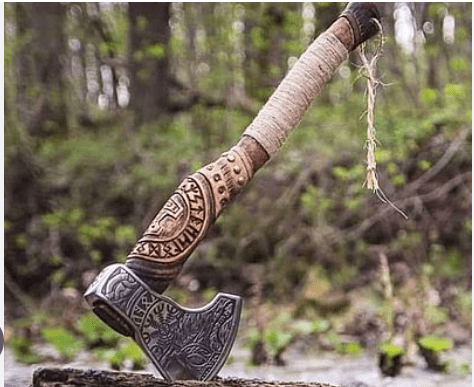Introduction: In the annals of Viking warfare, amidst the clash of swords and the thunder of shields, another formidable weapon emerged as a symbol of Norse ferocity and skill: the Viking axe. Beyond its use in hand-to-hand combat, the Viking axe was also wielded with deadly accuracy in the art of axe throwing. In this article, we delve into the ancient practice of Viking axe throwing in battle, exploring its techniques, tactics, and enduring legacy on the battlefield.
The Role of Axe Throwing in Viking Warfare: Axe throwing was a versatile and deadly skill employed by Viking warriors on the battlefield. In addition to close combat with melee weapons, Viking warriors would hurl their axes at enemy lines from a distance, disrupting formations, and sowing chaos among their foes. Axe throwing allowed Vikings to engage enemies beyond the reach of their swords and spears, inflicting casualties and weakening enemy morale before engaging in close-quarters combat.
Techniques and Training: Viking axes throwing required both strength and precision, as well as an intimate knowledge of the axe’s weight, balance, and trajectory. Warriors would often practice their throwing technique from a young age, honing their skills through repetitive drills and competitions. The throwing motion involved a swift, fluid movement, with the axe released at the precise moment to maximize accuracy and velocity. Additionally, Viking warriors developed specialized throwing techniques, such as the “overhand” and “underhand” throws, to adapt to different combat scenarios and distances.
Tactical Deployment: In battle, Viking axe throwers served as a mobile and versatile force, capable of striking from unexpected angles and exploiting vulnerabilities in enemy defenses. Axe throwers would often be positioned on the flanks or periphery of the battlefield, using cover and terrain features to conceal their movements and surprise their adversaries. Coordinated volleys of thrown axes could disrupt enemy formations, target high-value targets such as commanders or standard-bearers, and create openings for infantry charges or other tactical maneuvers.
Psychological Impact: Beyond its tactical utility, Viking axe throwing had a profound psychological impact on enemy forces. The sight of axe-wielding warriors hurling deadly projectiles from a distance instilled fear and uncertainty among enemy ranks, often causing panic and disarray. The whistling sound of axes in flight, followed by the sickening thud of impact, served as a grim reminder of the Norsemen’s relentless determination and formidable prowess in battle.
Enduring Legacy: The legacy of Viking axe throwing in battle endures in modern-day competitions, reenactments, and cultural festivals that celebrate Norse heritage and martial traditions. Enthusiasts and historians continue to study and practice the ancient art of axe throwing, paying homage to the skill and valor of their Viking ancestors. As we reflect on the history of Viking warfare, the art of axe throwing stands as a testament to the resourcefulness, adaptability, and indomitable spirit of the Norse warriors who once roamed the seas and conquered distant lands. Viking axe for sale



